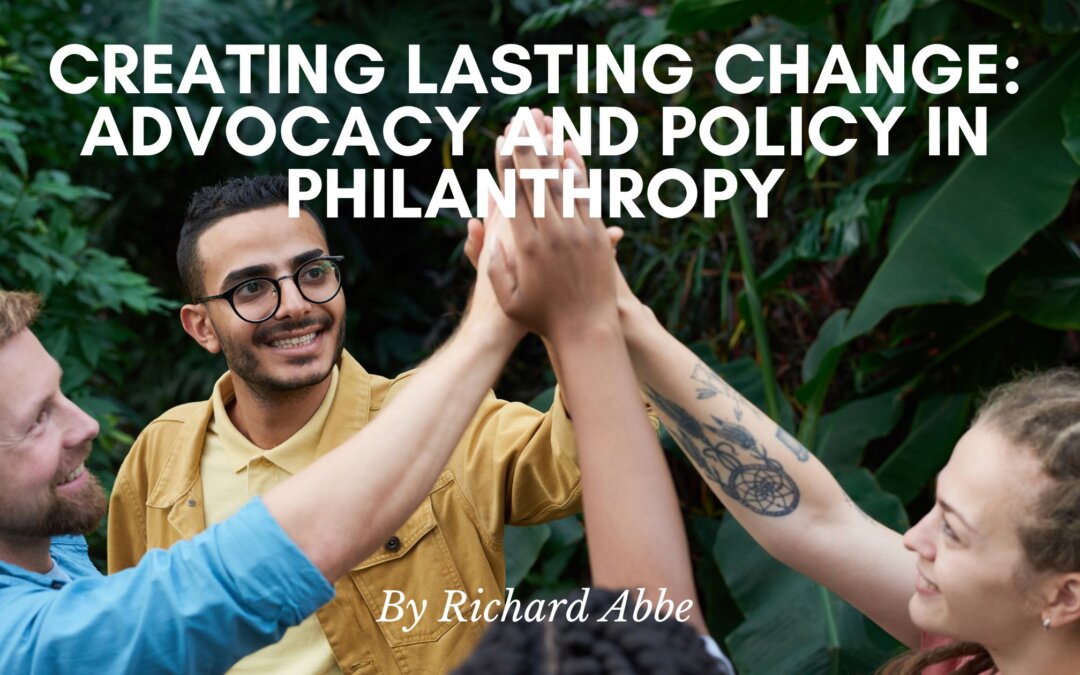Philanthropy is a powerful force for positive change in society. Beyond providing immediate relief and support to those in need, philanthropy can create lasting change by influencing policies and advocating for systemic reforms.
The Evolution of Philanthropy
Traditionally, philanthropy has been associated with acts of charity and benevolence, often manifested through donations to charitable organizations or direct assistance to needy individuals. While these actions are essential and have a significant impact, the philanthropic landscape has evolved to encompass a broader approach that addresses the root causes of societal challenges.
Advocacy vs. Direct Service
- Direct Service: Direct service philanthropy involves providing immediate aid, such as food, shelter, or medical care, to those in need. While this form of philanthropy addresses urgent and acute issues, it may need to address the underlying systemic causes of these problems.
- Advocacy: Advocacy philanthropy focuses on changing policies, systems, and structures to create sustainable, long-term solutions. It aims to address the root causes of societal challenges, advocating for policy reforms that benefit marginalized communities.
Why Advocacy Matters in Philanthropy
- Systemic Change: Advocacy allows philanthropists to tackle systemic issues that perpetuate inequality and injustice. By advocating for policy changes, philanthropy can address the root causes of problems, leading to lasting solutions.
- Scale and Impact: Advocacy efforts can potentially impact a broader audience than direct service alone. Policy changes can affect entire communities, regions, or even nations, leading to more significant and sustainable improvements.
- Leveraging Resources: Philanthropists can leverage their resources, networks, and expertise to influence policymakers and advocate for change. Philanthropy can amplify its impact by collaborating with other stakeholders, such as nonprofits, government agencies, and community organizations.
- Long-Term Vision: Advocacy philanthropy often involves a long-term vision for change. While direct service provides immediate relief, advocacy looks to create a future where such assistance is no longer needed.
Key Strategies in Advocacy Philanthropy
- Research and Analysis: Effective advocacy begins with a thorough understanding of the issues at hand. Philanthropists should invest in research and analysis to identify the root causes of problems, evaluate existing policies, and assess potential solutions.
- Policy Advocacy: Philanthropy can support policy advocacy efforts by funding organizations and initiatives that work to change laws and regulations. This may involve advocating for policies that promote social justice, environmental sustainability, or public health.
- Public Awareness and Education: Raising public awareness is crucial for advocacy success. Philanthropy can support campaigns that educate the public about pressing issues, engage communities in dialogue, and mobilize public support for policy change.
- Coalition Building: Collaboration is a powerful tool in advocacy. Philanthropists can facilitate coalition building among like-minded organizations, bringing together diverse stakeholders to work toward common goals.
- Capacity Building: Strengthening the capacity of advocacy organizations is essential for long-term impact. Philanthropy can provide funding and resources to build the skills, infrastructure, and expertise needed for effective advocacy work.
Challenges and Considerations in Advocacy Philanthropy
While advocacy philanthropy offers significant potential for creating lasting change, it also comes with challenges and considerations:
- Navigating Political Terrain: Advocacy often involves engaging with policymakers and navigating complex political landscapes. Philanthropists must be mindful of ethical considerations and potential conflicts of interest.
- Measuring Impact: Measuring the impact of advocacy can be challenging. Unlike direct service, where outcomes are often more tangible, the effects of advocacy may take time to materialize and may be influenced by multiple factors.
- Long-Term Commitment: Advocacy work is typically a long-term endeavor. Philanthropists should be prepared for sustained engagement, as policy change often requires persistence and resilience.
- Balancing Direct Service and Advocacy: Many philanthropists balance direct service with advocacy efforts. Striking the right balance is essential, as both approaches can complement each other in achieving meaningful change.
Case Studies in Advocacy Philanthropy
Several notable examples demonstrate the impact of advocacy philanthropy:
- Marshall Plan: After World War II, the Marshall Plan, funded by the United States, provided aid to European countries, helping them rebuild their economies. This example illustrates how strategic philanthropic investments can lead to significant policy changes and long-term economic recovery.
- Environmental Advocacy: Philanthropists like the Hewlett Foundation and the MacArthur Foundation have played a crucial role in funding environmental advocacy efforts, leading to the development of policies and initiatives to address climate change and conservation.
- Criminal Justice Reform: Advocacy philanthropy has been instrumental in pushing for criminal justice reforms in the United States. Initiatives funded by philanthropists have led to changes in sentencing laws, prison reform, and efforts to reduce mass incarceration.
Conclusion
Advocacy philanthropy represents a potent and transformative approach to addressing complex societal challenges. By focusing on systemic change and policy reforms, philanthropy has the potential to create lasting and sustainable improvements in the lives of marginalized communities and the broader society. While advocacy work may require a long-term commitment and careful consideration of ethical and political factors, its potential to drive positive change and promote justice and equity makes it a critical component of modern philanthropy. In an ever-evolving world, advocacy philanthropy serves as a beacon of hope, offering a path to a more just, equitable, and sustainable future.

